Huijia Wu
A*-Thought: Efficient Reasoning via Bidirectional Compression for Low-Resource Settings
May 30, 2025Abstract:Large Reasoning Models (LRMs) achieve superior performance by extending the thought length. However, a lengthy thinking trajectory leads to reduced efficiency. Most of the existing methods are stuck in the assumption of overthinking and attempt to reason efficiently by compressing the Chain-of-Thought, but this often leads to performance degradation. To address this problem, we introduce A*-Thought, an efficient tree search-based unified framework designed to identify and isolate the most essential thoughts from the extensive reasoning chains produced by these models. It formulates the reasoning process of LRMs as a search tree, where each node represents a reasoning span in the giant reasoning space. By combining the A* search algorithm with a cost function specific to the reasoning path, it can efficiently compress the chain of thought and determine a reasoning path with high information density and low cost. In addition, we also propose a bidirectional importance estimation mechanism, which further refines this search process and enhances its efficiency beyond uniform sampling. Extensive experiments on several advanced math tasks show that A*-Thought effectively balances performance and efficiency over a huge search space. Specifically, A*-Thought can improve the performance of QwQ-32B by 2.39$\times$ with low-budget and reduce the length of the output token by nearly 50% with high-budget. The proposed method is also compatible with several other LRMs, demonstrating its generalization capability. The code can be accessed at: https://github.com/AI9Stars/AStar-Thought.
Beyond Face Swapping: A Diffusion-Based Digital Human Benchmark for Multimodal Deepfake Detection
May 22, 2025Abstract:In recent years, the rapid development of deepfake technology has given rise to an emerging and serious threat to public security: diffusion model-based digital human generation. Unlike traditional face manipulation methods, such models can generate highly realistic videos with consistency through multimodal control signals. Their flexibility and covertness pose severe challenges to existing detection strategies. To bridge this gap, we introduce DigiFakeAV, the first large-scale multimodal digital human forgery dataset based on diffusion models. Employing five latest digital human generation methods (Sonic, Hallo, etc.) and voice cloning method, we systematically produce a dataset comprising 60,000 videos (8.4 million frames), covering multiple nationalities, skin tones, genders, and real-world scenarios, significantly enhancing data diversity and realism. User studies show that the confusion rate between forged and real videos reaches 68%, and existing state-of-the-art (SOTA) detection models exhibit large drops in AUC values on DigiFakeAV, highlighting the challenge of the dataset. To address this problem, we further propose DigiShield, a detection baseline based on spatiotemporal and cross-modal fusion. By jointly modeling the 3D spatiotemporal features of videos and the semantic-acoustic features of audio, DigiShield achieves SOTA performance on both the DigiFakeAV and DF-TIMIT datasets. Experiments show that this method effectively identifies covert artifacts through fine-grained analysis of the temporal evolution of facial features in synthetic videos.
Rethinking Class-Incremental Learning from a Dynamic Imbalanced Learning Perspective
May 24, 2024



Abstract:Deep neural networks suffer from catastrophic forgetting when continually learning new concepts. In this paper, we analyze this problem from a data imbalance point of view. We argue that the imbalance between old task and new task data contributes to forgetting of the old tasks. Moreover, the increasing imbalance ratio during incremental learning further aggravates the problem. To address the dynamic imbalance issue, we propose Uniform Prototype Contrastive Learning (UPCL), where uniform and compact features are learned. Specifically, we generate a set of non-learnable uniform prototypes before each task starts. Then we assign these uniform prototypes to each class and guide the feature learning through prototype contrastive learning. We also dynamically adjust the relative margin between old and new classes so that the feature distribution will be maintained balanced and compact. Finally, we demonstrate through extensive experiments that the proposed method achieves state-of-the-art performance on several benchmark datasets including CIFAR100, ImageNet100 and TinyImageNet.
Dynamic Generation of Personalities with Large Language Models
Apr 10, 2024

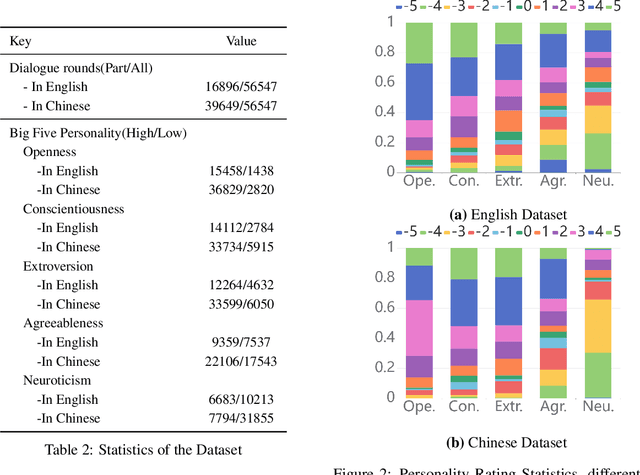

Abstract:In the realm of mimicking human deliberation, large language models (LLMs) show promising performance, thereby amplifying the importance of this research area. Deliberation is influenced by both logic and personality. However, previous studies predominantly focused on the logic of LLMs, neglecting the exploration of personality aspects. In this work, we introduce Dynamic Personality Generation (DPG), a dynamic personality generation method based on Hypernetworks. Initially, we embed the Big Five personality theory into GPT-4 to form a personality assessment machine, enabling it to evaluate characters' personality traits from dialogues automatically. We propose a new metric to assess personality generation capability based on this evaluation method. Then, we use this personality assessment machine to evaluate dialogues in script data, resulting in a personality-dialogue dataset. Finally, we fine-tune DPG on the personality-dialogue dataset. Experiments prove that DPG's personality generation capability is stronger after fine-tuning on this dataset than traditional fine-tuning methods, surpassing prompt-based GPT-4.
HyperMoE: Paying Attention to Unselected Experts in Mixture of Experts via Dynamic Transfer
Feb 25, 2024



Abstract:The Mixture of Experts (MoE) for language models has been proven effective in augmenting the capacity of models by dynamically routing each input token to a specific subset of experts for processing. Despite the success, most existing methods face a challenge for balance between sparsity and the availability of expert knowledge: enhancing performance through increased use of expert knowledge often results in diminishing sparsity during expert selection. To mitigate this contradiction, we propose HyperMoE, a novel MoE framework built upon Hypernetworks. This framework integrates the computational processes of MoE with the concept of knowledge transferring in multi-task learning. Specific modules generated based on the information of unselected experts serve as supplementary information, which allows the knowledge of experts not selected to be used while maintaining selection sparsity. Our comprehensive empirical evaluations across multiple datasets and backbones establish that HyperMoE significantly outperforms existing MoE methods under identical conditions concerning the number of experts.
Shortcut Sequence Tagging
Jan 03, 2017

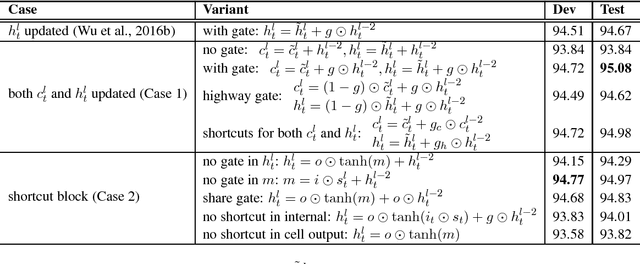

Abstract:Deep stacked RNNs are usually hard to train. Adding shortcut connections across different layers is a common way to ease the training of stacked networks. However, extra shortcuts make the recurrent step more complicated. To simply the stacked architecture, we propose a framework called shortcut block, which is a marriage of the gating mechanism and shortcuts, while discarding the self-connected part in LSTM cell. We present extensive empirical experiments showing that this design makes training easy and improves generalization. We propose various shortcut block topologies and compositions to explore its effectiveness. Based on this architecture, we obtain a 6% relatively improvement over the state-of-the-art on CCGbank supertagging dataset. We also get comparable results on POS tagging task.
An Empirical Exploration of Skip Connections for Sequential Tagging
Oct 11, 2016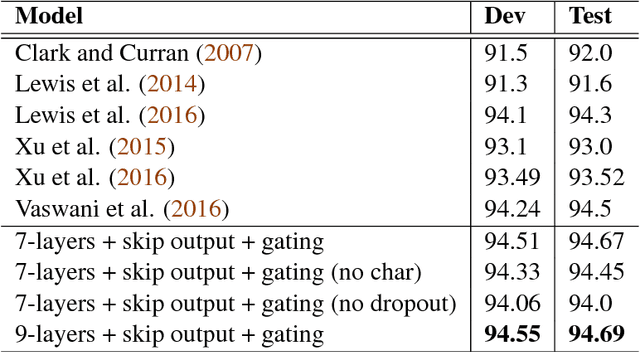

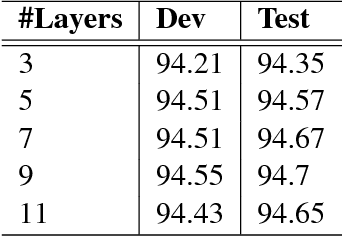

Abstract:In this paper, we empirically explore the effects of various kinds of skip connections in stacked bidirectional LSTMs for sequential tagging. We investigate three kinds of skip connections connecting to LSTM cells: (a) skip connections to the gates, (b) skip connections to the internal states and (c) skip connections to the cell outputs. We present comprehensive experiments showing that skip connections to cell outputs outperform the remaining two. Furthermore, we observe that using gated identity functions as skip mappings works pretty well. Based on this novel skip connections, we successfully train deep stacked bidirectional LSTM models and obtain state-of-the-art results on CCG supertagging and comparable results on POS tagging.
A Dynamic Window Neural Network for CCG Supertagging
Oct 10, 2016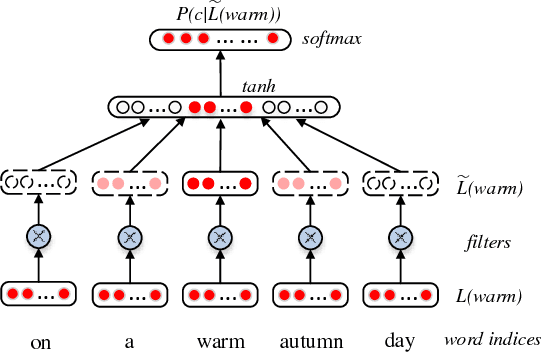

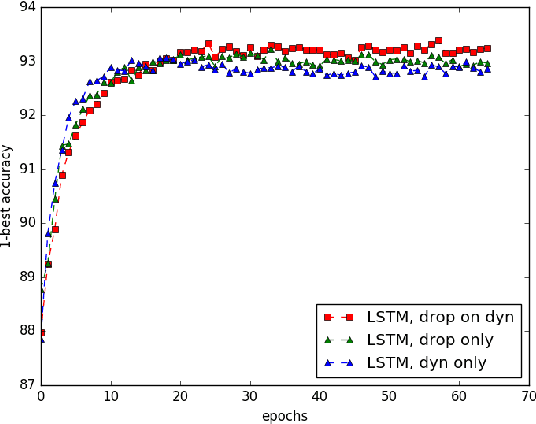

Abstract:Combinatory Category Grammar (CCG) supertagging is a task to assign lexical categories to each word in a sentence. Almost all previous methods use fixed context window sizes as input features. However, it is obvious that different tags usually rely on different context window sizes. These motivate us to build a supertagger with a dynamic window approach, which can be treated as an attention mechanism on the local contexts. Applying dropout on the dynamic filters can be seen as drop on words directly, which is superior to the regular dropout on word embeddings. We use this approach to demonstrate the state-of-the-art CCG supertagging performance on the standard test set.
 Add to Chrome
Add to Chrome Add to Firefox
Add to Firefox Add to Edge
Add to Edge